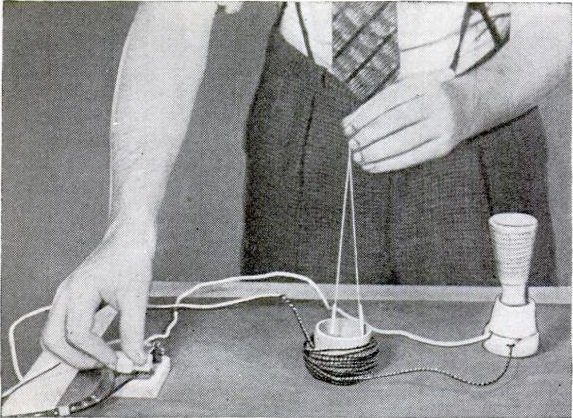 Last month, we showed how Junior can win the science fair blue ribbon by making a hot-wire ammeter. That device, however, required a bit of precise construction, and the idea might not work if he hasn’t started yet and the project is due tomorrow.
Last month, we showed how Junior can win the science fair blue ribbon by making a hot-wire ammeter. That device, however, required a bit of precise construction, and the idea might not work if he hasn’t started yet and the project is due tomorrow.
Today, however, we have a project that can be put together in one evening, using parts that can be found around the house, or from the local hardware store. While not as precise, this meter also measures AC current. Today’s project is from 80 years ago, from the October 1939 issue of Popular Science.
The meter consists of nothing more than several turns of wire around a cardboard tube. A piece of toilet paper tube will work well. Like most old projects, the instructions call for bell wire, since this was readily available back in the day. However, any type of insulated wire will work. Because relatively high currents will be used, it should be a fairly thick gauge. I would recommend buying a cheap extension cord, cutting off both ends, and then “unzipping” the two wires.
To make the project a bit safer, I would use another cheap extension cord cut in half. The plug end can be plugged in to an outlet strip and turned on when it’s time for the experiment. This would allow you to cover all exposed wires with electrical tape.
After cutting this extension cord in half, splice one set of wires back together. The remaining set of wires are connected to the coil. The plug end goes to one terminal of the coil, and the socket end goes to the other side of the coil. Into the socket, plug in an electric heater, which draws a large current.
Plug this in to the outlet strip and turn it on. The heater should be running, and all of the current is passing through the coil. Then, lower two iron or steel nails or screws on a string into the center of the coil. Since they are magnetized with the same polarity, they will repel one another. The higher the current, the further apart they are repelled. You can demonstrate this by switching the heater from high to low.
It should be noted that today’s project involves household current, and care must be taken not to touch any exposed wires, since contact could prove fatal.
